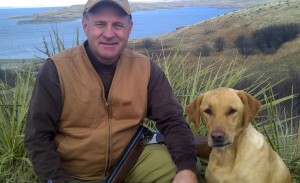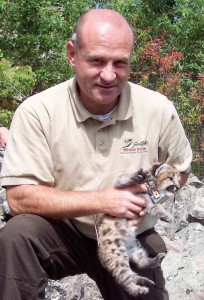Like a lot of graduates, the first thing Tony Leif wanted to do after getting his diploma was to get out of the state.
“When I got done (at SDSU), I was looking around and wanted to pursue a master’s degree. I wanted to go out of state and I also thought there was something out there that I was missing,†said Leif, who earned his bachelor’s in wildlife and fisheries management in 1985.
So he headed to Lubbock to pursue a master’s degree in wildlife science at Texas Tech University.
He got a fine education there, but one of the biggest things he learned was life is pretty good in South Dakota, especially for people wanting to hunt and fish.
“I missed the opportunities to be out there in the field. We have opportunities in South Dakota for most anyone to be able to get access to great hunting and fishing without having to pay for that access. It’s actually twofold—we have the natural resources and places to be able to access those resources on lakes and public lands or access to private land just by having family and friends,†Leif said.
Started as conservation officer
After earning his master’s degree in 1987, Leif returned to South Dakota, taking a job as a wildlife conservation officer in Freeman.
A year later, he became a wildlife biologist. For the next 16 years, he worked on wildlife research projects, coordinated statewide  private land habitat programs and directed a district field office in Huron.
private land habitat programs and directed a district field office in Huron.
His climb up the South Dakota Game, Fish and Parks ladder culminated with being appointed director of the Division of Wildlife in 2007.
In his seven years at the post, Leif has led his agency’s efforts to strengthen the connection of the wildlife division with citizens through advisory workgroups, public outreach programs, enhanced outdoor education and progressive use of electronic communication tools and social media. He has also led efforts to further enhance those hunter and angler access opportunities that brought him back to the state and has emphasized a pragmatic approach to the application of sound science and social considerations in the development of fish and wildlife laws and regulations.
As wonderful as Leif’s work has been, the job also comes with divergent public opinions and strong feelings on fish and wildlife management.
In a position like director of the Division of Wildlife, there are inevitably going to be those unhappy with the decisions. Competing viewpoints make it impossible to make everyone happy. Leif admits that is a struggle for him at times.
“It really comes down to the reason we have the challenges we have is because outdoor enthusiasts are really passionate about fish and wildlife. A lot of people live in this state because of not only the wildlife but also the hunting and fishing areas. It’s really important to people.â€
While that may be a challenge at times, it is also rewarding.
“It provides a lot of motivation for us to provide those opportunities. We get to see people enjoy life in South Dakota because of the work we do,†he said.
Interest sparked by dad, flamed by Flake
Leif explained that his own interest in working in wildlife management came as a result of getting the chance to hunt and fish in high school. Growing up in Huron, which bills itself as Ringneck Nation, going pheasant hunting was a boy’s rite of passage. He fondly remembers going out with his father on opening day in 1975 at age 12, the first year a hunter can be licensed.
His bait-and-tackle pursuits came later more through the influence of friends.
By the time he was a junior in high school, Leif knew he wanted a career in wildlife management “and it was pretty obvious where to get that education.†His schooling at SDSU instilled a broad-based knowledge of applied wildlife science that he has drawn upon in his work in wildlife management, he said.
Equally important was the enthusiasm and work ethic that his professors, particularly Les Flake, transferred to their students, he said.
Making the outdoors accessible
Those qualities are vital as Leif wrestles with the big issues facing the division—habitat loss with more land going into crops, aquatic invasive species and balancing the tug-of-war between resident hunters, out-of-state hunters and property owners who want to offer paid opportunities to hunting parties.
He continuously is “identifying the proper balance between the economic vitality of our state and ensuring a future of the natural resources we enjoy.
“That quality-of-life thing is very important for people. Future generations deserve to see and enjoy the same resources we have here today. You need the resources and a strong commitment so that the average South Dakotan has a realistic opportunity to get out and enjoy those resources.â€
Game, Fish and Parks has leased 1.25 million acres of private land under the Walk-In Area program. Another 100,000 acres are enrolled in similar programs.
“There’s always room for more access. It’s a continuous effort on the part of the state. We have good programs, but there are other opportunities out there. If you’re satisfied with where you’re at, you’re probably moving backward,†said Leif, who added that the division also tries to grow interest in the outdoors through Outdoor Campus classes in Sioux Falls and Rapid City.
Each campus has about 100,000 visitors per year. In Sioux Falls, nearly 6,000 people enrolled in one of the 307 hunting or fishing classes in 2014.
The ideal place to be
“A career working in wildlife is so rewarding because I get to work with citizens that are so enthused about fish and wildlife and a staff (of 280) that is highly motivated, highly dedicated. It’s really gratifying to be part of the agency responsible for managing our natural resources,†Leif said.
Should Leif need more motivation, he can just escape his Pierre office for an afternoon.
“There are two ideal times to be in South Dakota—when leaves start to grow on the trees and when the leaves start to fall,†he said. He likes throwing his hook in Lake Oahe and stalking pheasants. Most always, he is joined by at least one or more of his four children.
“With both fishing and hunting, it is not necessarily the place but the people who are around me that make it an enjoyable trip,†Leif said.






